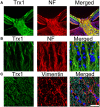Molecular mechanisms of retinal ganglion cell degeneration in glaucoma and future prospects for cell body and axonal protection
- PMID: 23316132
- PMCID: PMC3540394
- DOI: 10.3389/fncel.2012.00060
Molecular mechanisms of retinal ganglion cell degeneration in glaucoma and future prospects for cell body and axonal protection
Abstract
Glaucoma, which affects more than 70 million people worldwide, is a heterogeneous group of disorders with a resultant common denominator; optic neuropathy, eventually leading to irreversible blindness. The clinical manifestations of primary open-angle glaucoma (POAG), the most common subtype of glaucoma, include excavation of the optic disc and progressive loss of visual field. Axonal degeneration of retinal ganglion cells (RGCs) and apoptotic death of their cell bodies are observed in glaucoma, in which the reduction of intraocular pressure (IOP) is known to slow progression of the disease. A pattern of localized retinal nerve fiber layer (RNFL) defects in glaucoma patients indicates that axonal degeneration may precede RGC body death in this condition. The mechanisms of degeneration of neuronal cell bodies and their axons may differ. In this review, we addressed the molecular mechanisms of cell body death and axonal degeneration in glaucoma and proposed axonal protection in addition to cell body protection. The concept of axonal protection may become a new therapeutic strategy to prevent further axonal degeneration or revive dying axons in patients with preperimetric glaucoma. Further study will be needed to clarify whether the combination therapy of axonal protection and cell body protection will have greater protective effects in early or progressive glaucomatous optic neuropathy (GON).
Keywords: axonal degeneration; axonal protection; glaucoma; optic nerve; retinal ganglion cell.
Figures


Similar articles
-
CNS axonal degeneration and transport deficits at the optic nerve head precede structural and functional loss of retinal ganglion cells in a mouse model of glaucoma.Mol Neurodegener. 2020 Aug 27;15(1):48. doi: 10.1186/s13024-020-00400-9. Mol Neurodegener. 2020. PMID: 32854767 Free PMC article.
-
Autophagy in axonal degeneration in glaucomatous optic neuropathy.Prog Retin Eye Res. 2015 Jul;47:1-18. doi: 10.1016/j.preteyeres.2015.03.002. Epub 2015 Mar 26. Prog Retin Eye Res. 2015. PMID: 25816798 Review.
-
Assessment of retinal ganglion cell damage in glaucomatous optic neuropathy: Axon transport, injury and soma loss.Exp Eye Res. 2015 Dec;141:111-24. doi: 10.1016/j.exer.2015.06.006. Epub 2015 Jun 9. Exp Eye Res. 2015. PMID: 26070986 Review.
-
[Aiming for zero blindness].Nippon Ganka Gakkai Zasshi. 2015 Mar;119(3):168-93; discussion 194. Nippon Ganka Gakkai Zasshi. 2015. PMID: 25854109 Review. Japanese.
-
Pathophysiology of primary open-angle glaucoma from a neuroinflammatory and neurotoxicity perspective: a review of the literature.Int Ophthalmol. 2019 Jan;39(1):259-271. doi: 10.1007/s10792-017-0795-9. Epub 2017 Dec 30. Int Ophthalmol. 2019. PMID: 29290065 Review.
Cited by
-
Imaging of retinal ganglion cells in glaucoma: pitfalls and challenges.Cell Tissue Res. 2013 Aug;353(2):261-8. doi: 10.1007/s00441-013-1600-3. Epub 2013 Mar 20. Cell Tissue Res. 2013. PMID: 23512142 Free PMC article. Review.
-
Adeno-associated virus mediated SOD gene therapy protects the retinal ganglion cells from chronic intraocular pressure elevation induced injury via attenuating oxidative stress and improving mitochondrial dysfunction in a rat model.Am J Transl Res. 2016 Feb 15;8(2):799-810. eCollection 2016. Am J Transl Res. 2016. PMID: 27158370 Free PMC article.
-
Strip1 regulates retinal ganglion cell survival by suppressing Jun-mediated apoptosis to promote retinal neural circuit formation.Elife. 2022 Mar 22;11:e74650. doi: 10.7554/eLife.74650. Elife. 2022. PMID: 35314028 Free PMC article.
-
The neuroimmune-neuroplasticity interface and brain pathology.Front Cell Neurosci. 2014 Dec 4;8:419. doi: 10.3389/fncel.2014.00419. eCollection 2014. Front Cell Neurosci. 2014. PMID: 25538568 Free PMC article. No abstract available.
-
Normal-tension glaucoma: Pathogenesis and genetics.Exp Ther Med. 2019 Jan;17(1):563-574. doi: 10.3892/etm.2018.7011. Epub 2018 Nov 26. Exp Ther Med. 2019. PMID: 30651837 Free PMC article. Review.
References
-
- Aktas Z., Gurelik G., Göçün P. U., Akyürek N., Onol M., Hasanreisoğlu B. (2010). Matrix metalloproteinase-9 expression in retinal ganglion cell layer and effect of topically applied brimonidine tartrate 0.2% therapy on this expression in an endothelin-1-induced optic nerve ischemia model. Int. Ophthalmol. 30, 253–259 10.1007/s10792-009-9316-9 - DOI - PubMed
-
- Almasieh M., Lieven C. J., Levin L. A., Di Polo A. (2011). A cell-permeable phosphine-borane complex delays retinal ganglion cell death after axonal injury through activation of the pro-survival extracellular signal-regulated kinases 1/2 pathway. J. Neurochem. 118, 1075–1086 10.1111/j.1471-4159.2011.07382.x - DOI - PMC - PubMed
LinkOut - more resources
Full Text Sources
Other Literature Sources
Medical

